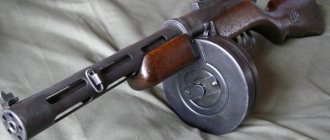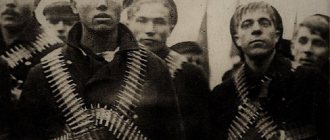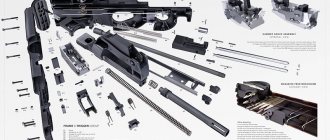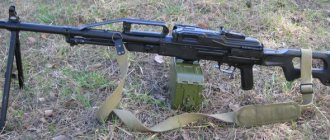Historical information
The MP-35 submachine gun was developed jointly by Emil Bargmann (son of the well-known gunsmith Theodor Bergmann) and designer Müller. In 1932, the right to produce the famous MP-18 submachine gun was sold to the Swiss company SIG. This contributed to the fact that the first prototype of the future MP-35 was born in the same year under the designation BMP 32. It was manufactured at the Danish company Schultz & Larsen.
MP-35 submachine gun
In Denmark, the MP-32 submachine gun was produced in its original version chambered for the 9x23 mm Largo (9mm Bergmann-Bayard) cartridge. In total, about 2,000 weapons were produced.
The MP-32 was in service with the Danish Armed Forces.
MP-35 submachine gun
2 years later, in 1934, the BMP-32 model was modernized and the BMP-34 (MP.34/I) was created on its basis. Due to the fact that the production base of the Bergmann company turned out to be insufficient, the legendary arms company Karl Walter took over production. The MP-34 was produced with both long and short barrels chambered for 9x19mm Luger, 7.63x25mm Mauser, 9x23mm Largo, .45 ACP and 9x25mm Mauser Export.
MP-35 submachine gun
A year later, the submachine gun was again modernized. This is how the BMP-35 version (MP.35/I) appeared, which had a simple design and was more suitable for mass production conditions.
ERMA EMP 36 submachine gun – half a step up from MP 38/40
The first submachine guns appeared during the First World War. According to their creators, this new type of rapid-fire small arms, which used an ordinary pistol cartridge, was supposed to significantly increase the firepower of the advancing troops. According to the terms of the Versailles Peace Treaty, Germany was allowed to arm police units with submachine guns. Therefore, in the 20s and 30s of the last century, work was actively carried out in the country to create new models of such small arms. One of those designers who was involved in the development of new submachine guns was the talented gunsmith Heinrich Volmer. In the period from 1925 to 1930, he managed to create several fairly successful examples of such weapons. In 1930, the German company ERMA (Erfurter Maschinenfabrik) bought all rights to the weapons created by Volmer. And soon the Nazis came to power in Germany, after which new submachine guns began to be developed for the needs of the army. So in the mid-1930s, ERMA converted the EMP submachine gun into the EMP 36 model, which became an intermediate option between the EMP and MP 38 models.
Submachine gun ERMA EMP
Immediately after acquiring the rights to weapons, the company began mass production of submachine guns designed by Volmer. Engineers put cooling casings on them, but otherwise the design of the submachine guns has remained virtually unchanged. After the purchase, the weapon received the new designation EMP (Erma Maschinenpistole). Since 1932, these models have been offered for sale within the country, as well as to third countries. At the same time, the company tried to adapt the weapon to the requirements of specific customers; for this reason, the submachine gun was produced in several basic versions. They differed from each other mainly in barrel length, caliber, type of sight used, and the presence or absence of a safety lock.
Experts today identify three main modifications of EMP submachine guns. The first is with a 30 cm barrel, a bayonet attachment point and a tangential sight. These submachine guns were supplied by Germany to the countries of Central and Eastern Europe, in particular to Yugoslavia and Bulgaria. The second model was the most popular and was considered standard. The barrel length was 25 cm, there was no bayonet mount, some models had a simplified L-shaped sight, others had a tangential type sight. Most often, such submachine guns were equipped with a safety lock. The third version of the EMP was distinguished by the presence of a stock similar to the MP-18.1 submachine gun.
Submachine gun ERMA EMP 36
It is worth noting that submachine guns were a commercial success in the market. Of course, it could hardly be called significant, but it should not be underestimated either. In total, at least 10 thousand EMP submachine guns were produced in Germany, but the exact volume of their production has not yet been established. A batch of these submachine guns was purchased in 1936 by the SS, which used these weapons throughout the Second World War.
At the beginning of 1936, the German Armaments Directorate presented a report to the Wehrmacht High Command on the state and prospects for the development of submachine guns. The report contained conclusions about the need to equip technical branches of the military and partly infantry with similar weapons. Taking into account these recommendations, the task was set to create individual automatic weapons for crews of tanks and armored personnel carriers, who would use submachine guns for self-defense in the event of emergency evacuation from equipment. The weapon had to be developed taking into account the fact that it would be used in the cramped conditions of the fighting compartments of tanks and armored vehicles.
"Yasen-M": long-awaited, necessary and expensive
Submachine gun ERMA EMP 36
In the same year, the director of the arms company ERMA, Dr. Berthold Geipel, proactively began designing the required weapons based on samples already produced by the company. He took the fairly well-mastered EMR submachine gun as the initial model. When working, the designers proceeded from the future specifics of the use of such weapons by armored vehicle crews: most often the shooting would be forced. This predetermined a number of design elements of the new submachine gun. In particular, it was the first to implement the idea of a folding stock, the barrel casing was removed, and for the convenience of firing from the tank, the reloading handle was moved to the left side of the bolt box, and a special device appeared on the barrel - a support hook, which was necessary for reliable fastening of the pistol -machine gun in the embrasure of an armored vehicle. It is worth noting the truly revolutionary technology for producing the main parts of the new weapon: instead of traditional machine processing, a qualitatively new method of cold stamping of parts from a thin steel sheet was used. Previously, this method was used mainly only in the automotive industry. The use of stamping made it possible to significantly reduce labor costs and, as a result, the cost of the submachine gun. The German designers of the ERMA company managed to create a unique design that had a direct impact on the entire further evolution of this type of small arms.
The new 9-mm submachine gun received the official designation EMP 36 and was designed to combat enemy personnel at a distance of up to 200 meters. The EMP 36 submachine gun consisted of a barrel with a bolt; a bolt with a firing pin connected together with parts of the return mechanism (moving system); forend with folding stock, trigger box, trigger mechanism and box magazine. The use of a folding metal stock of the original design made it possible to reduce the length of the weapon from 831 mm (folded stock) to 620 mm (folded stock). This model also features a pistol grip fire control.
Submachine gun ERMA EMP 36
In the EMP 36 submachine gun, a new design solution was implemented for the magazine neck, which was moved downwards, although not strictly vertically to the barrel of the weapon, but with a slight shift to the left. This approach finally made it possible to overcome the old disadvantage of German-designed submachine guns, which was associated with the side arrangement of the magazines. The transfer of the center of gravity to the plane of symmetry of the submachine gun immediately had a very positive effect on the accuracy of fire from the weapon, regardless of the emptying of the magazine, especially if the shooter fired continuously. A 32-round box magazine was created especially for this model, which differed from previously produced magazines in a number of details.
The automatic operation of the EMP 36 submachine gun worked on the principle of blowback. This model used a striker-type impact mechanism; it was powered by a reciprocating mainspring. The trigger mechanism was taken virtually unchanged from the EMP model. The weapon had a fire type translator. Its button was located above the pistol grip fire control. The only safety feature of the submachine gun was an elbow cutout on the bolt box, into which the weapon’s reloading handle was inserted when retracted to the rearmost position. The return spring, as in the EMP submachine gun model, was enclosed in telescopic guide tubes. There was a buffer spring in the firing pin channel, which, together with the relatively large (738 grams) mass of moving parts (striker, bolt and return mechanism), the rollout of the free bolt at the moment of firing and the long stroke of the automatic system, made it possible to reduce the rate of fire to 350-400 rounds per minute.
Submachine gun ERMA EMP 36
For the EMP 36 model, the process of servicing weapons has been significantly simplified. Now, to disassemble the submachine gun, instead of pressing the lever protruding beyond the trigger guard and separating the bolt box from the butt, which was not entirely convenient in the EMP model, it was only necessary to pull back the locking bolt, turning it 1/4 of a turn, and with the trigger pressed separate the barrel with the bolt box and the moving parts of the automatic submachine gun from the stock with the trigger mechanism and the folding metal butt.
New machine gun based on RPK-16. Make something good out of something great?
After the start of mass production, it became clear that the stamped parts were not yet reliable enough. Therefore, when the head of the ERMA company, Berthold Geipel, received an official order from the Wehrmacht Armament Directorate to develop a new submachine gun for paratroopers, tank crews and police officers, he had to return again to the technology of machining the main parts of weapons. In the period from 1936 to 1938, the EMP 36 submachine gun was modified into the MP 38. This model of the submachine gun was officially adopted on June 29, 1938, becoming a truly mass model of small arms and one of the symbols of the Second World War.
MP 38 submachine gun
For its time, the MP 38 submachine gun had a revolutionary design. No wooden parts were used in its design. The absence of a wooden stock not only made it more convenient for paratroopers and tankers, but also lighter. When producing the MP 38 submachine guns, wood was not used at all, only metal and plastic, which was first used in the design of submachine guns.
Performance characteristics of EMP-36: Caliber – 9 mm. Cartridge – 9x19 mm Parabellum. Total length – 831 mm. Length with folded stock – 620 mm. Barrel length – 250 mm. Weight without cartridges - 3.96 kg. The magazine is box-shaped with 32 rounds. The initial bullet speed is 360 m/s. Rate of fire – up to 350-400 rds/min. Target firing range – 200 m.
Sources of information: https://zonwar.ru/pp/mp_36.html https://militaryarms.ru/oruzhie/pulemety/mp-38-i-mp-40 https://war-arms.info/strelkovoe-oruzhie /pistoleti-pulemeti-i-avtomati/germaniya/erma/pistoleti-pulemet-erma-mp-36.html Materials from open sources
Project evaluation. Production and Application
From 1935 to 1940, 5,500 MP-35 units were produced. In 1939, the submachine gun was adopted by the Swedish army.
MP-35 submachine gun
Among the German military, in particular the Waffen SS troops, the MP-35 was highly praised as a reliable weapon with a fairly high accuracy of fire. This most likely contributed to the fact that the following companies received a license to produce a submachine gun: American Colt, Italian Beretta, German Junker&Ruh AG
MP-35 submachine gun
In total, about 176 units of the MP-35 and its modifications were produced. In Hitler's Germany, weapons were produced from 1940 to 1945 and a total of 55,000 units were produced. Waffen SS troops received 44,000 units.
MP-35 submachine gun
This weapon was in considerable demand in China, Yugoslavia, Italy, Iran and the USA, where about 121,000 of them were produced under patents.
The weapon was widely used during the Spanish Civil War and was used by some European countries. Used by American airborne and motorized rifle units from 1949 to 1970. The submachine gun was used during the Vietnam and Korean Wars by the United States and its allies.
MP-35 submachine gun
The submachine gun was in service with:
- Germany. Mainly used by Waffen SS and police forces.
- Denmark. The BMP-32 variant was in service with the Danish army from 1932 until the occupation.
- Sweden. Since 1939 it has been in service with the army under the designation M/39.
- Switzerland. The Ksp m/39 was in service and was produced until 1970.
- France. Used by the Foreign Legion and the Army until 1970.
- Israel. A small number of weapons were supplied in 1947-1950. Partially used by the Israel Defense Forces and police until 1975.
- Ethiopia. It was purchased from Germany and took part in the Italo-Abyssinian War.
- Bolivia. A small purchased pariah.
- USA. Produced by Colt mainly for export under the symbol M-35. Used by the army during some wars.
MP-35 submachine gun
Especially for police forces and special units in the United States, MP-35 variants with both removable and non-removable silencers, a shoulder rest and a handle were developed. There is also an option for left-sided placement of the magazine receiver.
MP 35 and ERMA EMP submachine guns
Despite the good firing characteristics of the submachine gun of the Schmeisser system mod. 1928 (MP 28), in the 1930s it became obvious that it was hopelessly outdated. Soon the Wehrmacht troops completely abandoned its use, and by 1933 it remained only in service with police forces. A new interest in submachine guns among the military arose during the war between Bolivia and Paraguay in 1932–1934. This weapon performed well in quick firefights at short distances and in street battles.
In the conditions of the ensuing excitement, almost every German department tried to solve the problem of arming its paramilitary units with submachine guns in its own way. As a result, by 1939, Luftwaffe ground units found themselves armed with MP 34 submachine guns, captured during the occupation of Austria. The Wehrmacht, having carried out a small modernization, returned to service the submachine gun of the Schmeisser system mod. 1928, and the SS troops and the police subordinate to them turned their attention to submachine guns of the Bergmann system.
MP 35 submachine gun
As a prototype when creating his new submachine gun, the famous German designer and industrialist T. Bergman chose the well-proven MP 28. As a result of a small modernization, two models were produced. 1934 (short-barreled) and mod. 1935 (long-barreled). The latter was adopted by SS units and police forces under the designation “Bergmann MP 35 submachine gun.” During the Spanish Civil War, Bergman's weapons were already widely used by both the Germans and Italians.
The weapon, developed jointly by Theodor Bergman and Müller, was equipped with a unique part for its class - a cocking handle borrowed from the Mauser 98k carbine. Before the first shot, the weapon had to be cocked, like a carbine. During firing, the charging handle remained stationary, the weapon mechanism was completely closed, and every moving part was protected from contamination.
Read: German fighter Heinkel He 112
Due to insufficient production capacity, it never carried out serial production of its submachine gun. The first license for mass production of weapons was received by the Danish company, a well-known manufacturer of sporting and hunting weapons. The Danish Armed Forces were among the first customers of the MP 35 submachine guns. A significant number of these weapons were supplied to the South African states, as well as to Ethiopia and China. By this time, the production of weapons of this type had long been mastered in Germany by Zella-Mehlis (since 1934) and Junker und Ruh AG from Karlsruhe (since 1935).
The MP 35, supplied to the SS troops, was fired with standard 9 mm caliber cartridges (9×19 “Parabellum”). For export, submachine guns of the Bergman system were produced with the ability to use 9 mm Bergmann-Bayard and Mauser cartridges, 7.63 mm Mauser cartridges, 7.65 mm Parabellum cartridges and even American .45 ACP.
From a design point of view, these submachine guns are very interesting weapons. The shooting accuracy of Bergman's weapon and the reliability of its operation were highly praised. At the same time, the MP 35 inherited most of the shortcomings of the Schmeisser system submachine gun mod. 1928. He failed to get rid of the excessive bulkiness, large mass and unbalanced design, aggravated by the location of the store on the left. In addition, the Bergmann submachine guns also had a number of their own shortcomings, the main one being the complexity of the design, as well as the high cost of time and money for production.
In connection with the massive transition of all German armed forces to the use of the Vollmer MP 38 submachine gun that began in 1938, production of the MP 35 was discontinued. In total, about 40,000 units of these weapons were produced between 1935 and 1938.
Submachine gun ERMA EMP
Another type of submachine gun adopted in Germany before the appearance of the most popular MP 38 and MP 40 models was the EMP submachine gun (ERMA Maschinen pistole). This model was developed long before it was put into service - back in the mid-20s. XX century - based on the design of engineer Heinrich Vollmer and patented in 1927. The design of this weapon used Volmer’s proposed scheme for placing a return mainspring inside a telescopic tube system. Thus, the spring was protected from contamination and the reliability of the submachine gun as a whole was significantly increased. This weapon received its designation from the name of the manufacturer ERMA (Erfurter Maschinenfabrik B. Geipel GmbH), founded in October 1924. The director of the company was Berthold Geipel, who headed the Royal Rifle Factory in Erfurt, which was closed after the First World War.
Read: Heavy cruisers of the Admiral Hipper class
Vollmer's first weapon, a modification of the Bergman MP 18 submachine gun, was produced in small batches at the small Vollmer engineering factory in Biberach. The Reichswehr officially abandoned this weapon due to Versailles restrictions, and small batches (totaling up to 500 copies) of the Volmer submachine gun sold abroad did not satisfy the designer. After the start of cooperation with Geipel, the situation changed, which, however, was facilitated not only by the authority of ERMA, but also by the increased interest of the German military in submachine guns. Soon mass production of the Folmer submachine gun began, first under the designation "Folmer-ERMA", and then in a modified version as the ERMA EMP. It was the latter weapon that served as the basis for the development of other models - MP 38 and MP 40, which were produced in large quantities until the end of World War II.
Volmer submachine gun in 1925–1938. was produced in several versions (including those released in Biberach) - with various fuses, stock shapes, with or without a casing around the barrel (an option for tankers), and despite a wide advertising campaign, it was in service with the German police only in limited quantities. This weapon had much greater success abroad. Thus, Volmer submachine guns were purchased in large quantities by France, Yugoslavia and Latin American countries. In 1936–1939 Large quantities of these submachine guns were sent to Spain to arm Italian troops and units of the German Condor Legion. Since 1940, licensed production of these weapons has been established in Spain.
Read: Smith & Wesson revolvers (USA)
During World War II, the EMR submachine gun was also used by the SS troops to arm reconnaissance units. With the outbreak of World War II, the SS troops managed to replenish their arsenal with EMP submachine guns captured as trophies from the French army. Under the designation MP 740 (f), these captured submachine guns were also used by Wehrmacht units. The Volmer submachine gun was made from high quality materials, which inevitably affected its cost. It was also distinguished by its large mass and not the most successful sight, which did not allow targeted fire over long distances.
You might be interested:
- MP 18 and MP 28 submachine guns
- MP 38 and MP 40 submachine guns
- MP 18 submachine gun
- Submachine gun "Steyr-Solothurn" S1-100/MP 34
- Degtyarev submachine guns PPD-34 and PPD-40
- MP 41 submachine gun
Subscribe to
our channel in Yandex.Zen
Design and operating principles
The MP-35 project is based on old documentation for the MP-18 by Hugo Schmeiser. Despite the similarities, the MP-35 still differs from its parent in the location of the magazine on the right side and other design features.
Design of the MP-35 submachine gun
In this weapon, fire is fired from an open bolt; automatic action with a blowback bolt is used. The USM allows for single fire and burst fire. This is done by changing the length of the trigger stroke. When you press it completely, the submachine gun fires in bursts, and incomplete pressing provokes a single fire. The cocking handle is located in the rear part of the cylindrical receiver. To cock the bolt, you need to turn the handle up at a right angle, then pull it back. The same principle applies to bolt action rifles, such as the Mauser rifle. When firing, the bolt handle remains motionless.
MP-35 submachine gun
The fuse is a slider moving along the axis of the weapon. It is located on the left side of the receiver under the rear sight. The submachine gun is fed by a box magazine that attaches horizontally to the right.
The weapon's sight is sectoral, designed for distances from 100 to 500 meters.
German soldier with an MP.35/I submachine gun











